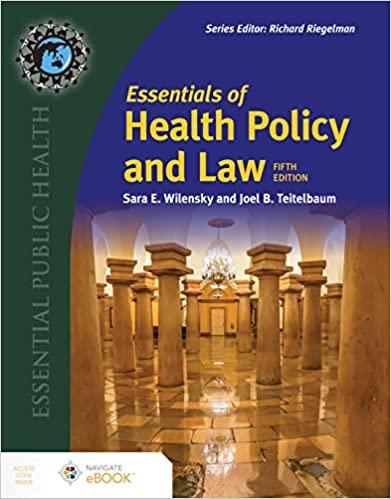Question
Read the following case study and answer the questions using internal citations. Provide full APA reference list. Ms. Gadner was driving her car on the
Read the following case study and answer the questions using internal citations. Provide full APA reference list.
Ms. Gadner was driving her car on the highway when another car driven by Mr. Sneed passed her, sideswiped her, ran her off the road, and drove off. She caught up with Mr. Sneed and forced him to stop. She got out of the car and started to walk to his car when he drove away. When she was walking back to her car, Mr. Otis struck her with his vehicle. Gadner was transported to Bay Hospital, a small rural hospital, where Dr. Dick, a second year pediatric resident, was the attending emergency room physician. Upon arriving at Bay, Gadner's skin was cool and clammy and her blood pressure was 95/55, indicative of shock. Gadner received 200 cc's per hour of fluid and was x-rayed. She actively requested a transfer because of vaginal bleeding. Nurse Gilbert voiced her own concerns about the need for a transfer to the other nurses in the emergency room, but not to Dr. Dick. Dr. Dick did not order a transfer. Bay is a rural hospital and is not equipped to handle trauma patients with multiple injuries like Gadner. Bay had no protocol or procedure for making transfers to larger hospitals. Bay breached its own credentialing procedures in hiring a physician who lacked the necessary training, expertise, or demonstrated competence to work the emergency room. Dr. Moon, the hospital's chief of staff, had screened Dr. Dick, but a proper evaluation was not performed before he was hired. A second year pediatric resident is not normally assigned to an emergency room setting, because they lack enough experience to handle true emergency cases. The nurses failed to notice that Gadner was in shock and this failure was substandard. After they initially noted that she arrived with cool and clammy skin and a blood pressure of 95/55, they did not advise Dr. Dick that the patient was likely in shock; they failed to place her on IV fluids, elevate her feet above her head and give oxygen as needed. Dr. Dick ordered the administration of 500 cc's of fluid per hour, but Gadner received only about 200 cc's per hour because the IV infiltrated, delivering the fluid to the surrounding tissue instead of the vein. The nursing staff normally would discover infiltration and correct it. Scanty nurse's notes reveal that vital signs were not taken regularly, depriving Dr. Dick of critical and ongoing information about Gadner's condition. Nurse Gilbert administered Valium and morphine to Gadner, following Dr. Dick's orders, a mixture of drugs counter-indicated for a patient with symptoms of shock. Nurse Gilbert did not notice or protest. Three hours after arriving at Bay, Gadner "coded" and Dr. Dick tried unsuccessfully to revive her. After she "coded," Dr. Dick attempted to use the laryngoscope, following standard practice, but the one provided was broken. He then ordered epinephrine, but there was none available in the emergency room. A coroner performed an autopsy and it was determined that Gadner died of treatable shock.
1. Excluding Mr. Sneed and Mr. Otis, list the potential defendants involved in the case.
2. Specify which of the potential defendants have possible legal liability to Ms. Gadner's estate by stating the legal theories of liability (ex: corporate negligence). Describe the person/entity's actions from the facts which create that liability under the legal theory you have identified (ex: breach of credentialing procedures in hiring).
3. Based on the legal theories and the facts you have identified, develop a VERY SPECIFIC list of short term (next 1 - 2 months) corrective actions the hospital must take immediately to remedy the problems. Be sure to have at least one short term corrective action for EACH of the legal issues you identified.
4. Then, develop a second VERY SPECIFIC list of long term (6 - 12 months) corrective actions the hospital must take to ensure this situation does not happen again. Be sure to have at least one long term corrective action for EACH of the legal issues you identified. (This list should NOT be same as the short term actions, but should instead build upon EACH of them.)
Step by Step Solution
There are 3 Steps involved in it
Step: 1

Get Instant Access to Expert-Tailored Solutions
See step-by-step solutions with expert insights and AI powered tools for academic success
Step: 2

Step: 3

Ace Your Homework with AI
Get the answers you need in no time with our AI-driven, step-by-step assistance
Get Started


